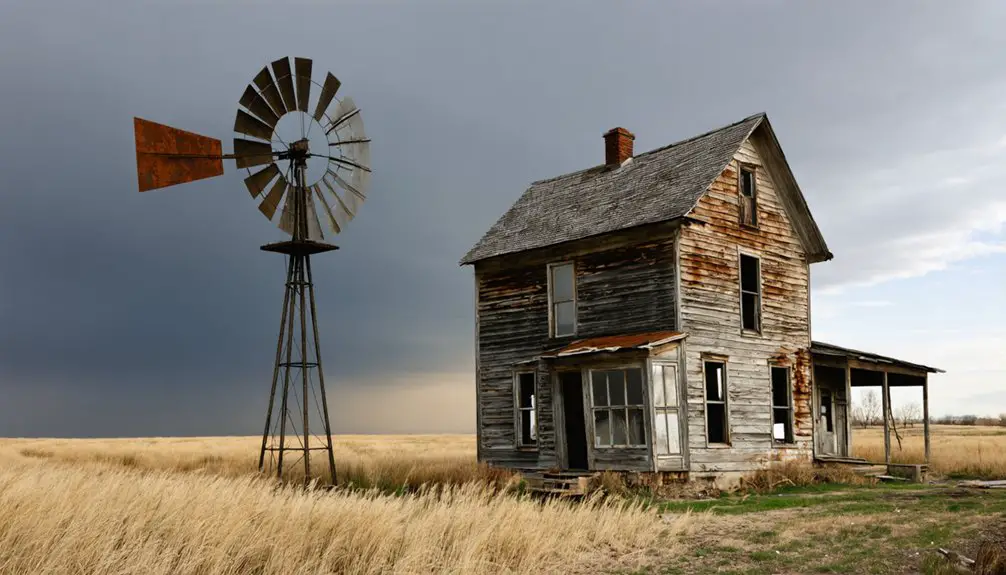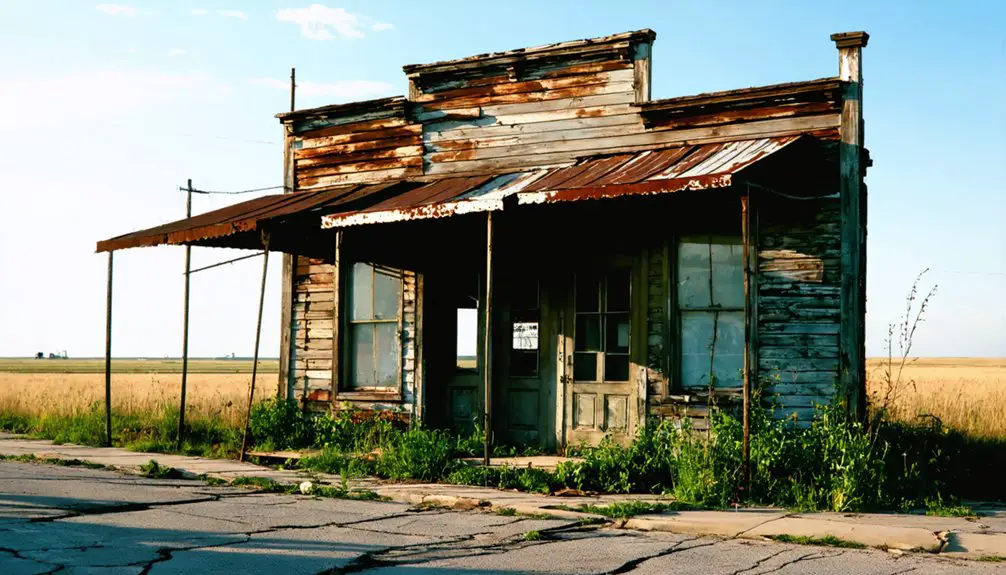You won’t find Fort Robinson among Nebraska’s abandoned ghost towns – it’s actually thriving as a state park today. Originally established in 1874 as Camp Robinson, this former military outpost witnessed pivotal frontier moments like Chief Crazy Horse’s surrender and housed German POWs during WWII. Nearly fifty original buildings still stand among the dramatic Pine Ridge escarpment, where history meets modern recreation. The fort’s compelling stories of conflict, tragedy, and transformation await your discovery.
Key Takeaways
- Fort Robinson is not a ghost town but an active state park with nearly fifty original military buildings still standing.
- The fort transitioned from an active military installation to a state park, preserving its historical structures and cultural heritage.
- Visitors can explore original cavalry barracks, officers’ quarters, and other military buildings dating back to the 1870s.
- The site maintains numerous recreational facilities, lodging options, and historical exhibits, making it a popular tourist destination.
- Unlike abandoned ghost towns, Fort Robinson continues to operate as a living historical site with year-round activities and accommodations.
The Strategic Location Among Nebraska’s Sandstone Bluffs
Nestled within Nebraska’s Pine Ridge escarpment, Fort Robinson‘s strategic positioning among dramatic sandstone bluffs gave it a commanding presence over the Great Plains landscape.
You’ll find this historic military outpost surrounded by rugged terrain that proved invaluable during the frontier conflicts of the 1870s.
The towering bluff formations served dual purposes – providing natural fortification and enabling vital military surveillance of the vast territories below.
The strategic bluffs offered both protection and expansive views, allowing soldiers to monitor movement across the sprawling plains beneath.
From these elevated vantage points, soldiers monitored approaching threats and maintained control over adjacent Lakota and Cheyenne lands.
The site’s proximity to the White River offered essential water access, while the high ground protected against flooding.
Today, you can still trace the fort’s defensive perimeter along Soldier Creek Road, where the sandstone canyons rise dramatically from the prairie, showcasing nature’s role in frontier military strategy. The fort’s expansive 22,000 acre territory stretches across a network of scenic trails and historic landmarks.
Visitors can experience the rugged terrain firsthand through guided Jeep tours that traverse the dramatic landscape while learning about the fort’s frontier history.
From Camp to Fort: The Early Military Years
You’ll find the origins of Fort Robinson in March 1874, when Captain Arthur MacArthur established a tent camp among the sandstone bluffs to protect the nearby Red Cloud Agency.
The installation, initially named Camp Robinson after the recently slain Lt. Levi H. Robinson, quickly grew into one of the largest military posts on the northern Plains. In January 1878, the camp was officially redesignated as Fort Robinson. The base played a vital role in preventing range wars between local ranchers and homesteaders moving into the territory.
Strategic Location Selection
When the U.S. military sought to establish Fort Robinson in 1874, they strategically selected its location near the newly relocated Red Cloud Agency along Nebraska’s White River.
You’ll find the fort’s positioning wasn’t random – it provided military oversight for over 13,000 Lakota who’d been resettled there, while ensuring proper distribution of treaty obligations and annuity goods.
The site’s natural advantages proved indispensable, with sandstone bluffs offering protection and the White River supplying essential water resources. The fort gained notoriety as the place where Crazy Horse surrendered in 1877.
Later, when the railroad arrived in the 1880s, you could see why this location became even more significant.
Fort Robinson’s placement made it the perfect command center for cavalry regiments, replacing Fort Laramie as the key military installation in the northern Great Plains. At its peak during the Indian Wars in 1876, the fort housed up to 1,000 troops who maintained order in the region.
Early Military Operations
The U.S. government authorized three strategic military camps in 1871, with Camp Robinson emerging as the most significant installation along Nebraska’s White River.
You’ll find the camp’s early military strategies centered on monitoring nearly 13,000 Native Americans in the region, leading to its establishment near the Red Cloud Indian Agency.
When you explore the initial troop engagements, you’ll discover the camp’s critical role in the Sioux Wars from 1876 to 1890.
The fort witnessed significant events, including the surrender of Crazy Horse with 1,100 followers in 1877 and the tragic Northern Cheyenne outbreak of 1879. The outbreak resulted in Chief Dull Knife’s band attempting to escape the harsh confinement conditions during winter.
During this period, the installation evolved from Camp Robinson to Fort Robinson, reflecting its transformation into a permanent military stronghold.
The post’s cavalry units, including the renowned 10th, 8th, and 12th regiments, shaped frontier warfare tactics.
Establishing Permanent Structures
Since its modest beginnings in March 1874, Camp Robinson grew from a collection of tents into a formidable military installation near the Red Cloud Agency. Under Captain William Jordan’s command, you’d have witnessed the rapid transformation of military architecture as temporary shelters gave way to substantial barracks and facilities that summer.
Local timber and stone became the building blocks of permanence, as construction techniques adapted to the harsh frontier environment.
The fort’s footprint expanded with officer quarters, enlisted barracks, storehouses, and a sturdy guardhouse. By the late 1870s, you’d have seen stable facilities and defensive earthworks rise from the prairie soil.
When the railroad arrived in the 1880s, the post’s growth accelerated dramatically, cementing Fort Robinson’s status as one of the northern Plains’ most significant military strongholds.
The fort would later serve a crucial role in managing the up to 13,000 Indians who camped in the surrounding area while awaiting their supplies and annuities.
Red Cloud Agency and Native American Relations
Located near the White River in northwestern Nebraska, Red Cloud Agency emerged in 1871 as an essential outpost for managing relations with the Oglala Lakota, Northern Cheyenne, and Arapaho peoples under the Fort Laramie Treaty of 1868.
You’ll find that despite Native American treaties promising food and supplies, corrupt agency officials often mismanaged resources, creating intense friction with the tribes.
At times, you’d have seen up to 13,000 Native Americans camped nearby, awaiting promised provisions in an increasingly volatile environment.
The agency facilities expanded to include two trading stores and a schoolhouse to serve the growing Native American population.
Oglala Chief Red Cloud fiercely resisted relocation attempts, insisting his people remain in their unceded territory.
When Sioux warriors killed the agency’s acting clerk in 1874, the military established Fort Robinson adjacent to the agency, marking a dramatic shift toward increased military control and suppression of Native resistance.
The Tragic Tale of Chief Crazy Horse

You’ll find Fort Robinson’s darkest chapter in the story of Crazy Horse, who surrendered to U.S. forces in 1877 only to meet his end there four months later.
When brought to the fort under false pretenses on September 5, the renowned Oglala leader was bayoneted by Private William Gentles during a desperate escape attempt from the guardhouse. Dr. McGillycuddy administered morphine for pain relief as the chief’s condition worsened.
Crazy Horse’s death that night became a defining moment in Native American history, symbolizing both the tragic cost of American westward expansion and the enduring spirit of Lakota resistance.
Surrender at Fort Robinson
After months of harsh winter conditions and relentless military pressure following the battles of Rosebud and Little Bighorn, Chief Crazy Horse and his band of northern Oglala leaders surrendered at Red Cloud Agency near Fort Robinson on May 5, 1877.
You’ll find the surrender dynamics were deeply complex – approximately 900 Lakota arrived in tatters, their resources depleted after resisting the government’s demands to move onto reservations following the Black Hills gold discovery.
The cultural impact of this surrender resonated throughout the Plains, as Crazy Horse’s influence drew both admiration and jealousy from other leaders who’d already adapted to reservation life.
While the ceremony was meant to protect his people from further military action, it ultimately set in motion the tensions that would lead to his tragic death months later.
Death of a Leader
Despite his peaceful surrender at Fort Robinson in May 1877, Chief Crazy Horse’s final months were marked by mounting tensions and political intrigue that ultimately led to his death.
Crazy Horse’s arrest came after rival chiefs spread rumors of his planned uprising, stoking fears among U.S. officials. You can trace the betrayal narrative through the events of September 5, 1877, when authorities lured him to Fort Robinson under false pretenses.
As soldiers attempted to imprison him, Crazy Horse resisted. In the struggle that followed, Little Big Man restrained him while Private William Gentles delivered a fatal bayonet wound.
That night, one of the greatest Native American leaders died in the post adjutant’s office. His father conducted a secret burial, forever guarding the location from those who’d betrayed his son.
Legacy Among His People
While Crazy Horse’s physical presence ended tragically at Fort Robinson, his spiritual and cultural influence among the Lakota people has only grown stronger through generations.
You’ll find his legacy deeply woven into the fabric of Lakota heritage, inspiring both Native and non-Native people to embrace the values of humility, bravery, and resistance against oppression.
- Led over 1,000 warriors in battle, demonstrating exceptional leadership during critical conflicts
- Never posed for photographs or boasted about achievements, embodying traditional Lakota values
- United various tribal bands in the struggle to protect ancestral lands
- Influenced countless generations through oral histories and cultural teachings
- Continues to serve as a powerful symbol of Indigenous sovereignty and cultural preservation
The spirit of Crazy Horse’s influence lives on through ceremonies, stories, and the monumental memorial being carved in the sacred Black Hills.
The Northern Cheyenne Breakout of 1879

In 1879, one of the most tragic episodes in Fort Robinson’s history unfolded when 149 imprisoned Northern Cheyenne attempted a desperate escape from the fort’s cavalry barracks.
These people had endured a grueling Northern Cheyenne Exodus from Oklahoma, only to face harsh Fort Robinson conditions – no food, water, or heat in the dead of winter.
You can still sense their desperation in the bitter cold of that January night, when they smashed through windows and fled into the moonlit snow.
The Army’s response was brutal: soldiers pursued them relentlessly, killing 64 Cheyenne, including women and children.
Of those who survived the -10°F temperatures and military pursuit, most were recaptured and later sent to South Dakota’s Pine Ridge Reservation.
Life at the Fort During the Indian Wars
The tragic Northern Cheyenne breakout marked just one chapter in Fort Robinson’s complex role during the Indian Wars. You’d find a bustling military outpost without defensive walls, where over 900 soldiers carried out harsh military tactics to control roughly 13,000 displaced Lakota and other tribes.
The fort’s primitive conditions and severe prisoner treatment reflected the brutal reality of America’s westward expansion.
- Soldiers conducted regular patrols to suppress Native American resistance
- Commanders used starvation and freezing conditions to force compliance
- Basic tent camps evolved into cavalry barracks and supply buildings
- Prisoners endured confinement without food, water, or winter heat
- The fort served as a critical supply and communication hub for military operations
The fort’s daily operations revealed a stark contrast between military authority and Native American autonomy, as soldiers enforced government policies through increasingly aggressive measures.
World War II and the POW Camp Era
During World War II, Fort Robinson transformed from a military outpost into one of America’s largest prisoner-of-war camps, housing up to 3,000 German POWs between 1943-1946.
Within the camp’s POW dynamics, you’d find a complex social hierarchy where Nazi sympathizers, making up about 30% of the population, wielded significant influence over other prisoners, particularly targeting Austrian-born detainees.
Prisoner life wasn’t all harsh though. You’d see POWs working on local farms, caring for thousands of horses, and earning wages under Geneva Convention rules.
They’d spend their free time playing soccer, putting on theatrical shows, and taking classes.
After the war ended, some former prisoners even returned to Nebraska as U.S. citizens, having formed lasting bonds with local residents during their time at Fort Robinson.
Preserved Buildings and Historical Landmarks
Nearly fifty original buildings still stand at Fort Robinson, offering visitors a remarkable window into America’s frontier military history.
You’ll find an impressive collection of historic buildings from the fort’s most active period (1874-1912), including the stately 1887 officers’ quarters and the commanding 1909 brick barracks.
Many structures have been creatively repurposed while preserving their historical integrity, like the quartermaster’s storehouse that’s now a playhouse.
- Original 1904 blacksmith shop and 1906 harness shop showcase cavalry support operations
- Fort Robinson Museum occupies the 1905 post headquarters building
- Trailside Museum of Natural History housed in the historic Army Theatre
- Former Veterinary Laboratory where scientists developed equine sleeping sickness vaccine
- Post cemetery serves as a solemn reminder of frontier military life
Fort Robinson State Park Today
Modern visitors to Fort Robinson State Park experience a remarkable blend of historical preservation and contemporary recreation across Nebraska’s largest state park.
You’ll find an impressive array of recreational activities spanning 22,000 acres, from 60 miles of hiking trails to mountain biking adventures through the scenic Pine Ridge landscape. The park’s visitor amenities include newly renovated lodging with upgraded furniture, ADA-accessible rooms, and both indoor and outdoor swimming pools.
You can immerse yourself in authentic Old West experiences through horseback riding, stagecoach tours, and evening chuckwagon cookouts.
Whether you’re casting a line for rainbow trout in Soldier Creek, watching bison roam the grounds, or attending a show at the Post Playhouse, Fort Robinson successfully bridges its historic past with modern outdoor pursuits.
Frequently Asked Questions
Are There Any Reported Ghost Sightings or Paranormal Activity at Fort Robinson?
You’ll find numerous ghost encounters at this historic fort, including crying children, Native American spirits, and Buffalo Soldier apparitions. Paranormal investigations have documented mysterious footsteps, voices, and moving objects throughout the grounds.
What Entertainment and Recreational Activities Were Available for Soldiers’ Families?
With over 20 miles of scenic trails, you’ll discover abundant family events from chuck wagon cookouts to weekly rodeos, plus recreational facilities including tennis courts, swimming pools, and a crafts studio.
How Many Soldiers Were Typically Stationed at Fort Robinson?
You’d find around 900 soldiers when the fort first opened in 1874, but numbers shifted throughout its military history. During peak Indian Wars, you’d typically see several hundred troops stationed there.
What Wildlife Species Can Visitors Commonly See Around Fort Robinson Today?
You’ll spot countless elk roaming majestically, white-tailed and mule deer darting through grasslands, and bison herds, making wildlife photography incredible. Bird watching enthusiasts can track eagles, hawks, and wild turkeys.
Did Any Notable Military Officers Serve at Fort Robinson Besides Those Involved?
You’ll find rich military history through officers like Charles Young, the highest-ranking Black officer of his time, and Captain Arthur MacArthur, father of General Douglas MacArthur, who both made significant contributions.
References
- https://ictnews.org/archive/relive-a-century-of-life-on-the-frontier-at-fort-robinson/
- https://en.wikipedia.org/wiki/Fort_Robinson
- https://www.legendsofamerica.com/ne-fortrobinson/
- https://www.atlasobscura.com/places/fort-robinson-state-park
- https://history.nebraska.gov/fort-robinson-history-center/brief-history-of-fort-robinson/
- https://outdoornebraska.gov/location/fort-robinson/
- https://liveandlethike.com/2022/12/27/mexican-canyon-trail-loop-inc-scenic-view-trail-fort-robinson-state-park-ne/
- https://www.islands.com/1883807/nebraska-family-friendly-educational-fort-robinson-state-park-natural-beauty-history/
- https://www.tripadvisor.com/Attraction_Review-g45508-d268048-Reviews-or30-Fort_Robinson_State_Park-Crawford_Nebraska.html
- https://history.nebraska.gov/fort-robinson-history-center/fort-robinson-timeline/



